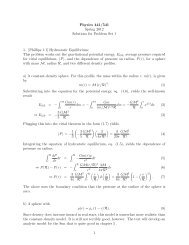Solutions
Solutions
Solutions
Create successful ePaper yourself
Turn your PDF publications into a flip-book with our unique Google optimized e-Paper software.
MasteringPhysics: Print View with Answers http://session.masteringphysics.com/myct/assignmentPrin...<br />
Find the wavelength of the light in the fluid. To do this, solve the equation from Part A for .<br />
Express your answer in nanometers, to four significant figures.<br />
ANSWER:<br />
Hint 2. Relating wavelengths and the index of refraction<br />
Recall that the wavelength of light in a medium is related to its wavelength in air by the relation ,<br />
where is the index of refraction for the medium.<br />
ANSWER:<br />
ANSWER:<br />
Understanding Fraunhofer Diffraction<br />
Description: The equations for Fraunhofer diffraction are derived. Then, a simple numerical problem is worked.<br />
Learning Goal:<br />
= 1.329<br />
= 476.2<br />
water ( )<br />
methanol ( )<br />
ethanol ( )<br />
acetone ( )<br />
isopropyl alcohol ( )<br />
saline ( )<br />
To understand the derivations of, and be able to use, the equations for Fraunhofer diffraction.<br />
Diffraction is a general term for interference effects related to edges or apertures. Diffraction is more familiar in waves with longer wavlengths than<br />
those of light. For example, diffraction is what causes sound to bend around corners or spread as it passes through a doorway. Water waves<br />
spread as they pass between rocks near a rugged coast because of diffraction. Two different regimes for diffraction are usually identified: Fresnel<br />
and Fraunhofer.<br />
Fresnel diffraction is the regime in which the diffracted waves are observed close (as compared to the size of the object causing the diffraction) to<br />
the place where they are diffracted. Fresnel diffraction is usually very complicated to work with. The other regime, Fraunhofer diffraction, is much<br />
easier to deal with. Fraunhofer diffraction applies to situations in which the diffracted waves are observed far from the point of diffraction. This<br />
allows a number of simplifying approximations to be used, reducing diffraction to a very manageable problem.<br />
An important case of Fraunhofer diffraction is the pattern formed by light shining through a thin slit onto a distant screen (see the figure).<br />
Notice that if the light from the top of the slit and the light from the bottom of the slit<br />
arrive at a point on the distant screen with a phase difference of , then the electric<br />
field vectors of the light from each part of the slit will cancel completely, resulting in a<br />
dark fringe. To understand this phenomenon, picture a phasor diagram for this scenerio<br />
(as show in the figure).<br />
A phasor diagram consists of vectors (phasors) with magnitude proportional to the<br />
magnitude of the electric field of light from a certain point in the slit. The angle of each<br />
vector is equal to the phase of the light from that point. These vectors are added<br />
together, and the resultant vector gives the net electric field due to light from all points in<br />
the slit. In the situation described above, since the magnitude of the electric field vectors<br />
is the same for light from any part of the slit and the angle of the phasors changes<br />
continuously from to , the phasors will make a complete circle, starting and ending<br />
at the origin. The distance from the origin to the endpoint of the phasor path (also the<br />
6 of 11 2/7/13 1:01 PM




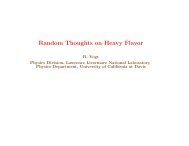
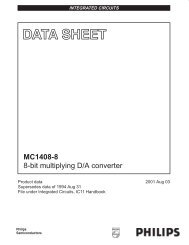

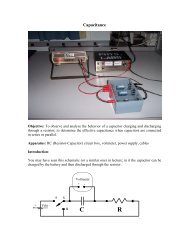


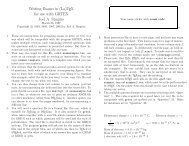
![More Effective C++ [Meyers96]](https://img.yumpu.com/25323611/1/184x260/more-effective-c-meyers96.jpg?quality=85)



